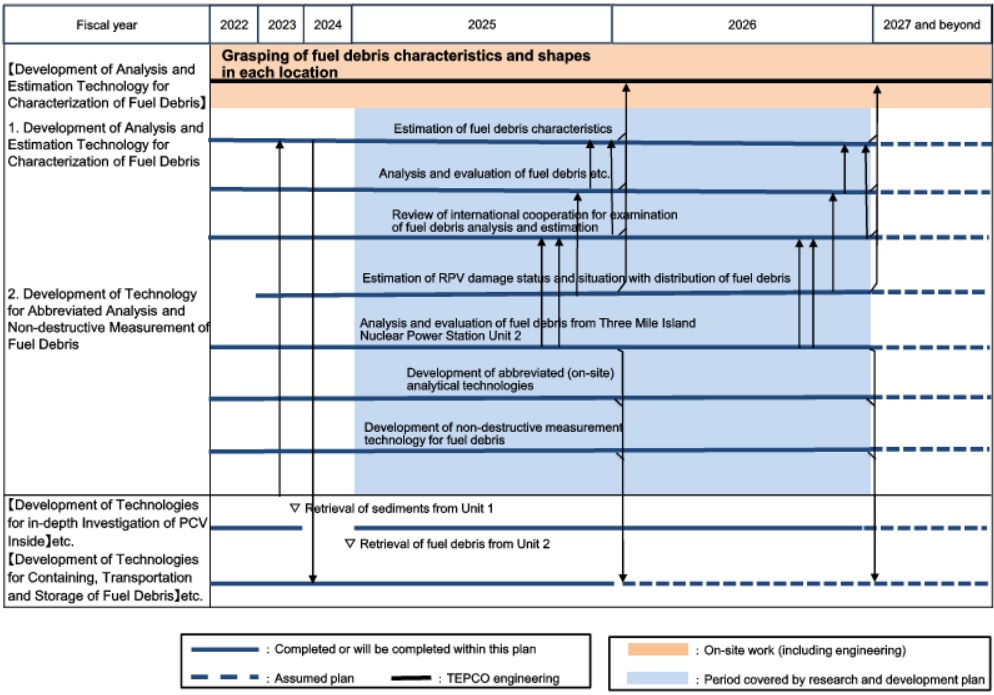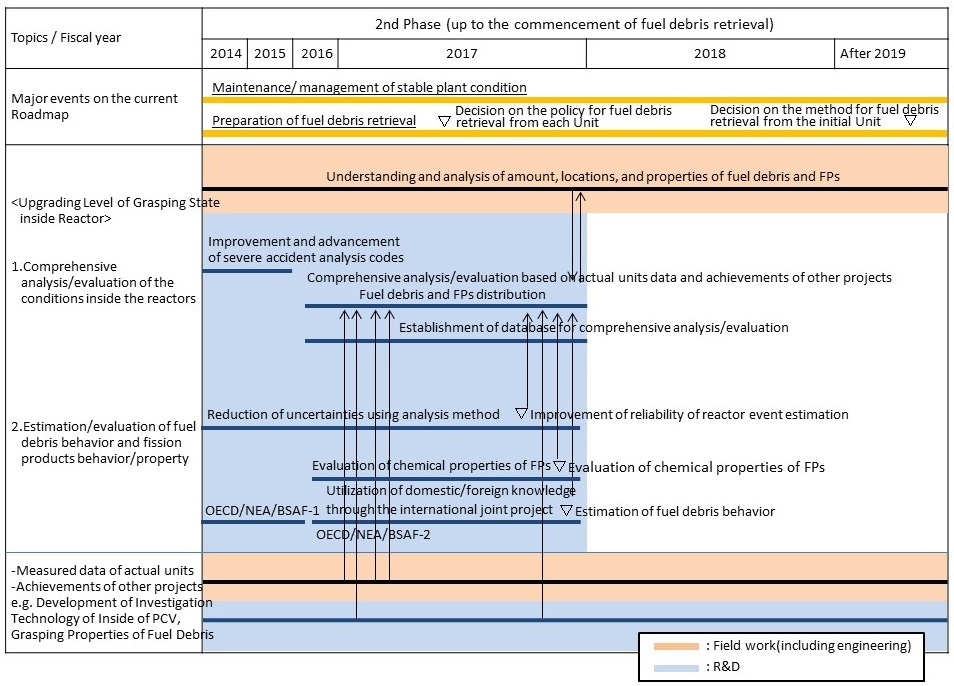Comprehensive analysis and evaluation of fuel debris and FP status
R&D efforts (Application development linked to plant applications and actual use)
Ongoing projects
Development of Analysis and Estimation Technology for Characterization of Fuel Debris (Project of Decommissioning and Contaminated Water Management)
Summary
In order to contribute to the development of fuel debris retrieval method and internal structures and technologies for containing, transportation and storage of fuel debris, technology necessary for quantitative analysis of components and estimation for characterization of fuel debris shall be developed.
Action items
- Development of Analysis and Estimation Technology for Characterization of Fuel Debris
- Development of Technology for Abbreviated Analysis and Non-destructive Measurement of Fuel Debris
Implementation plan

Source: FY 2024 Research and Development Plan for Decommissioning
(METI, Secretariat of the Team for Countermeasures for Decommissioning and Contaminated Water Treatment (February 27, 2025)) (PDF page 6-8)
Results & performance by fiscal year
- FY 2024
- Status of progress at the end of January 2023 (METI, Secretariat of the Team for Countermeasures for Decommissioning and Contaminated Water Treatment (February 27, 2025)) (PDF page 49-51 Japanese)
- FY 2023
- FY 2022
- FY 2021
- FY 2020
- FY 2019
- Status of progress at the end of February 2020 (METI, Secretariat of the Team for Countermeasures for Decommissioning and Contaminated Water Treatment (February 27, 2020)) (PDF page 18-19)
- Analysis of samples in PCV, etc. at Fukushima Daiichi NPS (METI, Secretariat of the Team for Countermeasures for Decommissioning and Contaminated Water Treatment (May 30, 2019)) (PDF)
- FY 2018
- FY 2017
- Interim report (Development of technologies for grasping and analyzing properties of fuel debris (April 2018)) (IRID) (PDF)
- Status of progress at the end of February 2018 (METI, Secretariat of the Team for Countermeasures for Decommissioning and Contaminated Water Treatment (March 1, 2018)) (PDF page 18)
- FY 2016
- Completion report (Grasping properties of fuel debris (May 2017)) (IRID) (PDF)
- Status of progress at the end of February 2017 (METI, Secretariat of the Team for Countermeasures for Decommissioning and Contaminated Water Treatment (February 23, 2017)) (PDF page 21)
- FY 2015
- Status of progress at the end of February 2016 (METI, Secretariat of the Team for Countermeasures for Decommissioning and Contaminated Water Treatment (February 25, 2016)) (PDF page 36)
- Summary of results (Understanding attributes of fuel debris, project plan and status of progress (October 2015)) (IRID) (PDF)
- FY 2014
- FY 2013
- Summary of results (METI, Secretariat of the Team for Countermeasures for Decommissioning and Contaminated Water Treatment (February 27, 2014)) (PDF page 6)
- Summary of results (Understanding attributes of mock debris, development of disposal technology) (June 27, 2014) (IRID) (PDF)
- FY 2012
- Summary of results (METI, Secretariat of The Council for the Decommissioning of TEPCO’s Fukushima Daiichi (March 28, 2013)) (PDF page 95)
Results & performance for individual projects, etc. (Archives)
Switch button
- Understanding fuel debris properties (Atomic Energy Society of Japan, 2015 Fall Meeting, Reactor Study Committee, “Mid-to-long term strategy and R&D at Fukushima Daiichi NPS” Separate session B-3, “Understanding fuel debris properties” (September 11, 2015)) (IRID) (PDF)
- Summary of research on fuel debris characteristics (Japan Society of Maintenology, 12th Scientific Lecture Meeting, Accident analysis, investigation inside the reactor, debris characteristics session) (July 14, 2015) (IRID) (PDF)
- Understanding fuel debris characteristics and treatment technology development at TEPCO Fukushima Daiichi NPS; FY2012 Report on Results of R&D (March 2014) (JAEA) (PDF)
Estimation of condition of core, PCV (TEPCO)
- Estimation of condition of core, PCV at Fukushima Daiichi NPS Units 1 to 3, and study of unsolved problems
With the objective of making continuous improvements to progress in decommissioning work and nuclear power station safety technology, we are in the process of extracting, investigating and studying 52 unchecked and unsolved problems on detailed development mechanisms after the accident occurred. We are releasing a report to summarize the results achieved from that study so far.
- 5th Progress Report (December 25, 2017)
- 4th Progress Report (December 20, 2015)
- 3rd Progress Report (May 20, 2015)
- Fukushima Daiichi NPS accident background and lessons
We are in the process of investigating and analyzing the progression of the accident at TEPCO’s Fukushima Daiichi NPS, and here we explain the lessons we learned from that analysis and the accident.
Completed projects
Upgrading Level of Grasping State inside Reactor (Project of Decommissioning and Contaminated Water Management)
Summary
We performed comprehensive analysis and assessment of fuel debris within reactors and fission product (FP) to attain a firmer understanding of them, in order to contribute to decision on method for fuel debris retrieval, and to confirm the stable condition of the plant. Specifically, we performed comprehensive analysis and assessment of conditions inside the reactor in order to obtain necessary data and information of fuel debris, and location and distribution of FP for each reactor, as well as the impact on integrity of PCV and structures in the reactor, criticality assessment, and FP behavior during retrieval. After performing that analysis and assessment we did sensitivity analysis and reverse analysis for each event, which were judged to be important for improving the reliability of the results of the analysis and assessment.
Action items
- Comprehensive analysis/evaluation of the conditions inside the reactors
- Estimation/evaluation of fuel behavior and features of debris and fission products
Implementation organization
Implemented by IRID and the Institute of Applied Energy.
Implementation plan

Source: Progress status of R&D projects and direction for next period
(METI, Secretariat of the Team for Countermeasures for Decommissioning and Contaminated Water Treatment (February 23, 2017)) (PDF page 3)
Results & performance by fiscal year
- FY 2017
- FY 2017 report of results (Upgrading level of grasping state inside reactor (June 2018)) (IRID) (PDF)
- Status of progress at the end of February 2018 (METI, Secretariat of the Team for Countermeasures for Decommissioning and Contaminated Water Treatment (March 1, 2018)) (PDF page 27)
- Estimate of situation in reactor core/PCV of Fukushima Daiichi NPS (The 2nd International Forum on the Decommissioning of the Fukushima Daiichi Nuclear Power Station (July 3, 2017)) (PDF)
- FY 2016
- Report of results (Upgrading level of grasping state inside reactor (June 2017)) (IRID) (PDF)
- Status of progress at the end of February 2017 (METI Secretariat of the Team for Countermeasures for Decommissioning and Contaminated Water Treatment (February 23, 2017)) (PDF page 21)
- FY 2015
- Completion report (Enhancing the understanding of conditions within reactors by accident progression analysis and data from actual equipment (March, 2016)) (IRID) (PDF)
- Status of progress at the end of February 2016 (METI Secretariat of the Team for Countermeasures for Decommissioning and Contaminated Water Treatment (February 25, 2016)) (PDF page 35)
- FY 2014
- FY 2013
- Summary of results (Understanding conditions within reactors by enhancing accident progression analysis technology (Status of progress at the end of February 2014) (February 27, 2014)) (IRID) (PDF page 5)
- Summary of results (Understanding conditions within reactors by enhancing accident progression analysis technology) (May 29, 2014) (IRID) (PDF)
- FY 2012
Results & performance for individual projects, etc. (Archives)
Switch button
- Assessment by using accident progression analysis codes
R&D efforts (related basic and generic research)
Analysis of debris properties, and processing technology (Decommissioning Basic Research: Human resource development program at Tohoku University- Basic research into reliability maintenance of PCV and buildings, etc., and waste processing and disposal, and core human resource development program for decommissioning)
Technology to measure nuclear material within fuel debris (Research by JAEA: Study of concomitant characteristics of nuclear materials of fission product in measurements of nuclear material using passive gamma measurement) (PDF)
Plant investigation, measurement date, and information
Efforts to understand the plant status at each of Units 1 to 3, and for fuel debris retrieval (October 7, 2025)
(METI, Secretariat of the Team for Countermeasures for Decommissioning and Contaminated Water Treatment)
- Current Status of Fukushima Daiichi NPS (As of July 31, 2025)
Plant-related parameters
- Plant-related parameters (Summary table) (PDF)
- Temperature parameters (Chart) Real-time data
- Unit 1 Temperature in the RPV (PDF)
- Unit 1 Temperature in the PCV (PDF)
- Unit 2 Temperature in the RPV (PDF)
- Unit 2 Temperature in the PCV (PDF)
- Unit 3 Temperature in the RPV (PDF)
- Unit 3 Temperature in the PCV (PDF)
- Fukushima Daiichi NPS plant data collected at the time of the accident (TEPCO)
- The Great East Japan Earthquake and Current Status of Nuclear Power Station(TEPCO)
- Outline of the plant (IRID) (PDF) only Japanese page
Fukushima Daiichi NPS survey map
Common data presented by Benchmark Study of the Accident at the Fukushima Daiichi Nuclear Power Plant (BSAF) related to accident progression analysis according to OECD/NEA
Information Portal for the Fukushima Daiichi Accident Analysis and Decommissioning Activities
Collection of figures of data on in-core situation (Updated regularly, August 2018)
Collection of links to data on in-core situation ( January 8, 2020)
- Grasping of fuel debris Only Japanese(PDF)
- Stability of fuel debris Only Japanese(PDF)
- Operation safety Only Japanese(PDF)
- Retrieval of fuel debris and others Only Japanese(PDF)
Chronology (Events after the accident, in-core situation, etc.)(Updated regularly, September 2018)
- Chronology of Fukushima Daiichi NPS (Excel File)
Other related information
Fukushima Daiichi NPS accident background and lessons: Estimations of the accident progression at each Unit (“Why did the accident occur?” and “Accident background”) (TEPCO)
- Accident background
- Why did the severe accident occur at Unit 1?
- Why did the severe accident occur at Unit 2?
- Why did the severe accident occur at Unit 3?
- Why did the hydrogen explosion occur at Unit 4?
- Accident process
- Accident process at Unit 1
- Accident process at Unit 2
- Accident process at Unit 3
- Accident process at Unit 4
- Reactor core conditions at Fukushima Daiichi NPS Units 1 to 3 (March 12, 2012) (PDF)
TEPCO Fukushima Daiichi NPS accident-related technology workshop
- Guidance materials
- Lecture materials